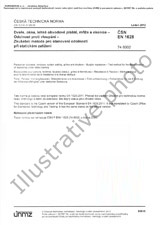We need your consent to use the individual data so that you can see information about your interests, among other things. Click "OK" to give your consent.
ČSN EN IEC 62942 (368695)
File format for professional transfer and exchange of digital audio data
Translate name
STANDARD published on 1.7.2020
The information about the standard:
Designation standards: ČSN EN IEC 62942
Classification mark: 368695
Catalog number: 510028
Publication date standards: 1.7.2020
SKU: NS-996412
The number of pages: 52
Approximate weight : 156 g (0.34 lbs)
Country: Czech technical standard
Category: Technical standards ČSN
The category - similar standards:
Annotation of standard text ČSN EN IEC 62942 (368695):
This document specifies a file format for interchanging audio data between compliant equipment. It is primarily intended for audio applications in professional recording, production, post-production, and archiving.
It is derived from the AES31-2 [2] but is also compatible with variant specifications including EBU Tech 3285 [3] to [10], ITU-R BR.1352-3-2007 [11] to [14], and the Japan Post Production Association´s BWF-J [15].
This document contains the specification of the broadcast audio extension chunk and its use with PCM-coded audio data. Basic information on the RIFF format and how it can be extended to other types of audio data is given in Annex E. Details of the PCM WAVE format are also given in Annex A.
An optional extended format, BWF-E, supports 64-bit addressing to permit file sizes greater than 4 GB
Preview of the standard ČSN EN IEC 62942 (368695)
We recommend:
Technical standards updating
Do you want to make sure you use only the valid technical standards?
We can offer you a solution which will provide you a monthly overview concerning the updating of standards which you use.
Would you like to know more? Look at this page.




 Cookies
Cookies
